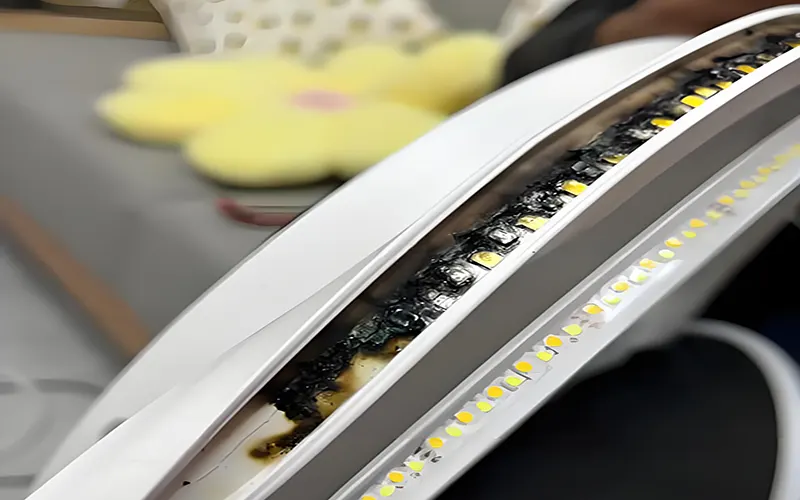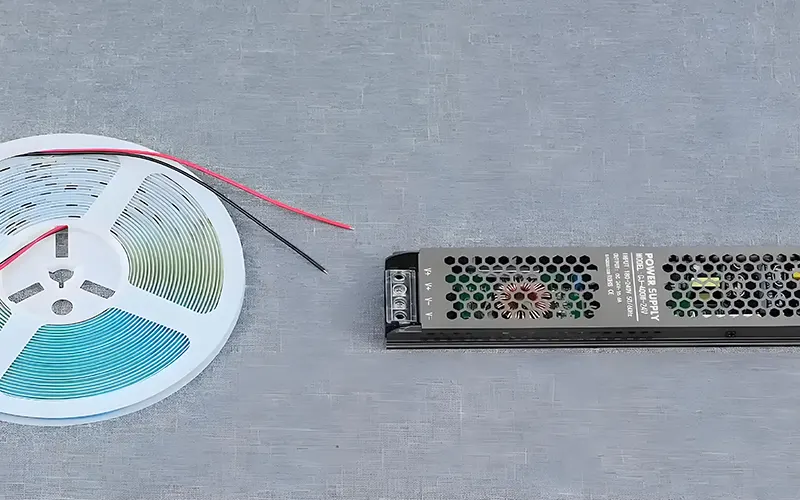Many users of LED light strips have noticed that after a period of use. Their once uniform and bright light strips have become partially darkened, with uneven light spots and decreased brightness. In particular, noticeable LED strip source”blackening” or “yellowish carbonization” appears around the lamp beads. This phenomenon not only seriously affects the lighting effect and visual aesthetics, but also signals the premature end of the lamp’s lifespan.
In fact, the blackening of LED strip light source is not accidental. It is caused by a combination of internal and external factors. Understanding these root causes can help you effectively avoid the risk of darkening during procurement, installation, and maintenance. More information, pls read Can LED Strip Lights Cause a Fire?
Degradation and Carbonization of the Phosphor Coating
The key to LED lamp beads emitting white light lies in the blue light chip stimulating the yellow phosphor coating on their surface. Which when mixed, creates white light. However, this coating is one of the core areas most susceptible to “blackening.”

It’s well known that when LEDs operate in high-temperature environments for long periods of time. The phosphor material will gradually degrade, age, and even carbonize due to thermal stress. Low-quality phosphors have poor heat resistance and may begin to decompose above 80°C. Resulting in reduced luminous efficiency, color temperature shift. And visible yellow or black spots on the surface of the lamp beads. In more serious cases, the phosphor may fall off or sinter, directly causing localised dimming.
In addition, encapsulating materials (such as silicone or epoxy resin) can also yellow under the combined effects of ultraviolet light and high temperatures. Further LED strip light source exacerbating the “blackening” appearance. This phenomenon is particularly common in light strips with high power density and poor heat dissipation.
Solution:
- Try to choose products with highly thermally stable phosphors.
- Make sure the manufacturer can provide an LM-80 test report.
- Keep the operating temperature of the light strip below the recommended upper limit to slow degradation.
Inadequate heat dissipation design
Heat is a life-threatening problem for LED lighting. Although LEDs are known as “cold light sources,” their electro-optical conversion efficiency isn’t 100%. And a significant amount of electrical energy is converted into heat. If heat dissipation is poorly designed, heat buildup will directly increase the LED junction temperature, triggering a series of chain reactions.
In fact, cheap LED strips use thin FPCs (flexible printed circuits) without an aluminum-based heat dissipation layer. Or are installed in a confined space, preventing effective heat dissipation. High temperatures not only accelerate phosphor aging but also oxidize solder joints and cause the PCB’s copper foil to blacken, potentially leading to poor solder joints or short circuits.
Solution:
- Choose a high-quality PCB with excellent heat dissipation.
- Use aluminum LED profiles or thermally conductive 3M adhesive for mounting.
- Allow adequate ventilation around the light strip.
- If the light strip is long, power it in sections to avoid local overheating.
Mismatched or poor-quality power supply
Another major cause is an insufficient power supply. Using an incompatible or low-quality power supply is also a common cause of partial blackening or even burning of the LED strip light source.

- Voltage Mismatch: If you choose a 12V LED light strip and mistakenly connect it to a 24V power supply. This will cause a surge in current and instantly burn out the LED chips. Even if the voltage is correct, if the power supply’s output current is unstable or pulsating, it can cause the LEDs to overload and overheat. How to choose the power supply, pls read How to Choose a Power Supply for LED Strips
- Insufficient or overloaded power: If the power supply wattage is less than the total power supply wattage of the light strip, the power supply will be in a chronic overload state, resulting in a drop in output voltage and abnormal light strip operation. Furthermore, if multiple light strips are connected in series for too long, exceeding the power supply’s capacity, the end LEDs will operate abnormally due to voltage decay, leading to localized overheating and blackening.
- Low-quality power supplies: Off-brand power supplies often use low-quality capacitors and transformers, resulting in poor anti-interference capabilities. They are susceptible to power grid fluctuations, resulting in high output ripple, which can damage LEDs over time.
Solution:
- Choose a high-quality power supply that’s CE and RoHS certified.
- Allow at least a 20% margin in power output.
- Preferably, use a driver with constant current output and short-circuit protection.
Humid and Corrosive Environments
LED strips frequently used in humid or highly corrosive environments, such as kitchens, patios, balconies, and outdoor landscapes, must be appropriately waterproofed. Water vapor, oil smoke, or salt spray can gradually penetrate the strip and cause chemical corrosion.
Water vapour intrusion can cause oxidation of the copper traces on the PCB, forming green patina or black copper oxide, especially around solder joints. This corrosion not only increases resistance and causes localized heating, but can also cause open circuits or short circuits, ultimately resulting in the LEDs turning black or burning out.
Solution:
- Choose LED light strips with an IP65 rating or higher.
- Use silicone potting or PU adhesive for moisture-proof packaging.
- Regularly maintain the integrity of the waterproof layer and avoid prolonged immersion in water or high humidity environments.
Improper Installation and Prolonged Overload Use
Even assuming the product itself is of acceptable quality, incorrect installation methods and usage habits can significantly shorten the lifespan of LED light strips and cause the light source to darken.
- Installation issues include: excessive bending of light strips, which can cause internal wiring breakage; using non-specific connectors, which can cause poor contact and localized heating; installing light strips in enclosed slots without sufficient heat dissipation space; and connecting multiple light strips in series for too long, resulting in insufficient voltage at the end or overheating.
- Long-term overload: Some users, driven by the desire for brightness, run light strips at full load or even overload (e.g., 24/7) for extended periods without rest breaks. This causes heat to accumulate and accelerates material degradation.
Solution:
Avoid sharp bends or pulling on the LED strip during installation.
It is recommended to rest the light strip every 10–12 hours to extend its life.
Conclusion
The Blackening of LED strip light source is often the result of a combination of factors, ranging from chip and phosphor quality to heat dissipation, power supply, packaging, environment, and usage habits. Each of these factors can pose a potential risk.
Therefore, the most effective solution isn’t to resort to repairs afterwards, but to choose high-quality products from professional manufacturers during the purchase process. If you’re shopping for a new light strip, consider consulting our expert advice on choosing a truly durable and safe product.
FAQs
Generally speaking, if you notice blackening or carbonization on the LED beads or PCB, it indicates irreversible physical or chemical damage that cannot be repaired. It’s recommended to cut off the damaged section and reconnect, or replace the entire LED strip.
You can test it by replacing a power supply with a comparable power supply. If the problem persists, it’s most likely a problem with the light strip’s materials or workmanship. If it returns to normal after replacing it, it’s likely a power supply issue.
There’s no definitive answer, as the lighting methods vary. 24V light strips have less voltage attenuation over long distances, resulting in more even heating at the ends, making them more stable in long-distance installations. However, 12V light strips longer than 5 meters without a repeater or parallel connections are prone to dark areas or overheating at the ends, posing a higher risk.
Qualified LED light strips, under normal use, should not show noticeable blackening within 3-5 years of their warranty period for indoor use.
